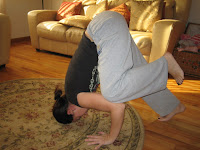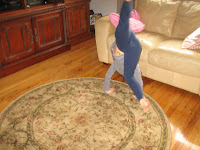Monday, March 21, 2011
3 Point Stance or Tip up- Starting Position
Get in a starting postion by getting on to your hands and knees placing your arms right under your shoulders.
The 3 point stance or tip up is a linear motion because all parts of the body are moving in the same direction at the same speed.
The 3 point stance or tip up is a linear motion because all parts of the body are moving in the same direction at the same speed.
3 Point Stance or Tip Up - Head position
Place your forehead on the mat and place your arms straight under your shoulders. Your arms and forehead should make a triangular shape.
Cue: Create a triangle with your head and hands.
Cue: Create a triangle with your head and hands.
3 Point stance or Tip Up- Balance
Balance both knees on each arm.
As you bend forward tip your hips up. Use your center of gravity to balance the weight between your arms and head.
Cue: Balance
Drill: this excerise would be used a lead up to the hand stand and head stand.
Works on core strength, balance and upper body strength.
As you bend forward tip your hips up. Use your center of gravity to balance the weight between your arms and head.
Cue: Balance
Drill: this excerise would be used a lead up to the hand stand and head stand.
Works on core strength, balance and upper body strength.
3 Point Stance or Tip Up- Dismount
Lower one leg at a time from your arms to the floor with extended leg and kneel down on your synovial joint before getting up.
Tuesday, March 1, 2011
Cartwheel- leap/hop up with dominant leg
The arms are in in flexion postion in the sagittal plane anterior view.
A cartwheel fall in the general motion because it involves both linear and rotation simultaneously.
Cartwheel- Place hands on floor
 Place the dominant hand down first followed by the non dominant hand to your dominant side. Lateral flexion to the right of the spinal column in the frontal plane is used. Force must be used to push and pull the appendicular skeleton back to it's anatomical position.
Place the dominant hand down first followed by the non dominant hand to your dominant side. Lateral flexion to the right of the spinal column in the frontal plane is used. Force must be used to push and pull the appendicular skeleton back to it's anatomical position.Cue: Kick up with straight legs and push with your hands.
Drill: Depending on the age and level place a mat folded on the floor and have the child place their hands and jump over the mat first with two feet then one foot at a time. Once they master that have them kick up off the floor one foot at a time with leg fully extended.
Cartwheel- Kick up with legs
Kick up with your non dominant leg (left) first then followed by your dominant leg(right) rotate. The foot leading should be in plantar flexion during movement. The non dominant leg is hyperextended during the initial kick up in the posterior.
Cue: Call out hand, hand , foot, foot.
Cartwheel- Landing Postion
 Landing down on your non dominant leg first and then bringing down your dominant leg. Your non dominant leg will land down in extension returning the body back to anatomical position followed by your dominant leg.
Landing down on your non dominant leg first and then bringing down your dominant leg. Your non dominant leg will land down in extension returning the body back to anatomical position followed by your dominant leg. Arms come up off the floor and should be upright in parallel postion overhead.A cartwheel is a lateral movement in the frontal plane around the anteroposterior axis.
Forward Roll- Squat
Squat down on the floor, placing the hands just in front of the feet. Make sure that their bottoms are not sticking out and that they have raised up on their tippy toes. When a forward roll is executed the entire body moves parallel to the sagital plane around the mediolateral axis.
Forward Roll- Tuck
Forward Roll- Roll
Roll their heads until the back of the head touchs the floor. Their legs should straighten a little as they roll their heads. Push off with their feet and perform a forward rotation.Remain in a tuck position while they roll. This rotation passes through the axis of rotation.
Cue: knees to chest (tuck)
Cue: knees to chest (tuck)
Forward Roll- Stand
Make sure that they lift their torsos from the ground and move their hands to either side of their feet.The arms are rotating medially in a horizontal adduction in the Transverse plane movement at the shoulder. Their knees should remain bent while they lift their torsos.
Drill: (tuck ) have them position themselves and place their heads on the floor. Standing up without the use of hands - have the child squat down with their bottoms almost on the floor and have them roll up and try and get up without using their hands. This works their core.
Definitons
1Rotation: Circular motion around an axis
2. Sagital Plane: plane in which forward and backward movements of the body and body segments occur.
3.Frontal Plane: Plane in which lateral movements of the body and body segments occur.
4. Flexion- one of the three primary movements occurring in the sagittal plane. Flexing hands over head.
5. Mediolateal axis- Imaginary line around which sagittal plane rotation occurs.
6. Anterior- Toward the front of the body.
7. Anteroposterior axis-Imaginary line around which frontal plane rotations occur.
8. Plantar flexion- pointing of the toes away from the shin bone " the ball of the foot" opposite of dorsiflexion.
9. Medial rotation- internal rotation towards the midline of the body .
10. Transverse plane- plane in which horizontal body and body segment movements occur when the body is in an erect standing postion.
11. Horizontal Adduction- movement in the transverse plane from a lateral to an anterior position.
12. Lateral flexion- sideway rotation of the trunk in a movement on the right or left side of the spinal column.
13. Hyperextended or hyperextension- is a movement in the sagittal plane which is normally posterior to the anatomical position. (movement of arms/legs)
14. Extension- is a movement in the sagittal plane which returns a body segment to anatomical position from a postion of flexion or hyperextension.
15. Posterior- Towards the back of the body.
16. Proximal- Closer in proximity to the trunk.
17. Axis of Rotation- Imaginery line perpendicular to the plane of rotation and passing through the center of rotation.
18. Balance- ability to control equilibrium
19 Linear- along a line that may be straight or curved, with all parts of the body moving in the same direction at the same speed.
20. Center of gravity- point around which a body's weight is equally balanced, no matter how the body is positioned.
21. Genaral motion- involoving translation and rotation simultaneously.
22. Force- push or pull; the product of mass and acceleration.
23 Appedndicular skeleton- bones composing the body appendages.
24 Anatomical position- erect standing position with all body parts, including the palms of the hands facing forward; considered the body starting position.
25.Synovial joint- freely movable only slight limitations to movement capability.
2. Sagital Plane: plane in which forward and backward movements of the body and body segments occur.
3.Frontal Plane: Plane in which lateral movements of the body and body segments occur.
4. Flexion- one of the three primary movements occurring in the sagittal plane. Flexing hands over head.
5. Mediolateal axis- Imaginary line around which sagittal plane rotation occurs.
6. Anterior- Toward the front of the body.
7. Anteroposterior axis-Imaginary line around which frontal plane rotations occur.
8. Plantar flexion- pointing of the toes away from the shin bone " the ball of the foot" opposite of dorsiflexion.
9. Medial rotation- internal rotation towards the midline of the body .
10. Transverse plane- plane in which horizontal body and body segment movements occur when the body is in an erect standing postion.
11. Horizontal Adduction- movement in the transverse plane from a lateral to an anterior position.
12. Lateral flexion- sideway rotation of the trunk in a movement on the right or left side of the spinal column.
13. Hyperextended or hyperextension- is a movement in the sagittal plane which is normally posterior to the anatomical position. (movement of arms/legs)
14. Extension- is a movement in the sagittal plane which returns a body segment to anatomical position from a postion of flexion or hyperextension.
15. Posterior- Towards the back of the body.
16. Proximal- Closer in proximity to the trunk.
17. Axis of Rotation- Imaginery line perpendicular to the plane of rotation and passing through the center of rotation.
18. Balance- ability to control equilibrium
19 Linear- along a line that may be straight or curved, with all parts of the body moving in the same direction at the same speed.
20. Center of gravity- point around which a body's weight is equally balanced, no matter how the body is positioned.
21. Genaral motion- involoving translation and rotation simultaneously.
22. Force- push or pull; the product of mass and acceleration.
23 Appedndicular skeleton- bones composing the body appendages.
24 Anatomical position- erect standing position with all body parts, including the palms of the hands facing forward; considered the body starting position.
25.Synovial joint- freely movable only slight limitations to movement capability.
Subscribe to:
Comments (Atom)























